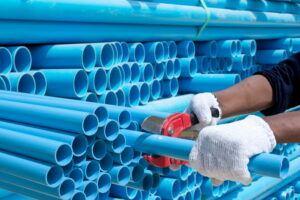 Indoor plumbing has a long history, and through it all the materials used for pipes have changed. If you live in an older home, your plumbing system may have outdated pipe material that needs to be replaced.
Indoor plumbing has a long history, and through it all the materials used for pipes have changed. If you live in an older home, your plumbing system may have outdated pipe material that needs to be replaced.
In this post, we’ve put together a list of the pipe materials commonly found in modern homes as well as the current materials plumbers use when doing jobs. We hope this will give you a better understanding of the work our plumbers may need to provide you when it’s time for repairs or repiping. If you have doubts about the type of pipes you have in your house, call us and we can find out what work may need to be done. For more on repiping, see our guide on whole-house repiping and whether it’s necessary for your home.
Outdated Materials
For many decades, the most common piping materials were lead, cast iron, and galvanized steel (steel dipped in a zinc solution). Many homes still have these materials, especially galvanized steel, which was still in use into the 1970s. Lead presents health problems, and both iron and steel are prone to decay from corrosion, which is why other materials have superseded them. A type of plastic, polybutylene, was used during the ‘70s and ‘80s, but had a tendency to break and has been taken out of use.
Copper
Copper piping is the most common metal found in residential and commercial use today. Copper offers a number of advantages over earlier pipe material: It’s lightweight and easy for plumbers to work with. It contains no lead and is safe for drinking water since it’s impermeable and keeps out chemical contaminants. Copper is corrosion-resistant (although there are a few types of corrosion that affect it), making it durable. It’s less likely to break under stress because of its greater flexibility compared to steel and iron. Copper is also a sustainable metal that can be easily recycled. Learn more about the benefits of professional plumbing and how it ensures proper material selection.
CPVC
Chlorinated polyvinyl chloride is one of the leading types of plastic pipes used in plumbing. It’s resistant to corrosion and chemical degradation and can handle water temperatures up to 200°F, making it ideal for hot water lines. The extra chlorine treatment for CPVC (as opposed to standard PVC) helps to stop bacterial growth within the pipe.
PEX
Cross-linked polyethylene pipes are popular for a range of uses in plumbing. PEX pipes are fully flexible so they can be used in tight, small spaces. They’re also inexpensive and less labor-intensive to work with compared to other types of plastic pipes, and have reduced resistance to water flow. PEX pipes come in different colors, making it simple for plumbers to designate them for cold and hot water lines.
Ultimately, when you work with a professional and knowledgeable plumber in Snellville, GA, you won’t have to put any thought into the types of piping used for installations, replacements, and repairs in your house. The plumber will know the right kind of material to use for each job. You can expect your home to have a mixture of piping materials, with each pipe chosen to perfectly match its use in the plumbing system. For proactive maintenance, check out our homeowner plumbing maintenance tips.
Your Comfort Is OUR Business at Snellville Heating, Air and Plumbing. Call us today for plumbing service.



